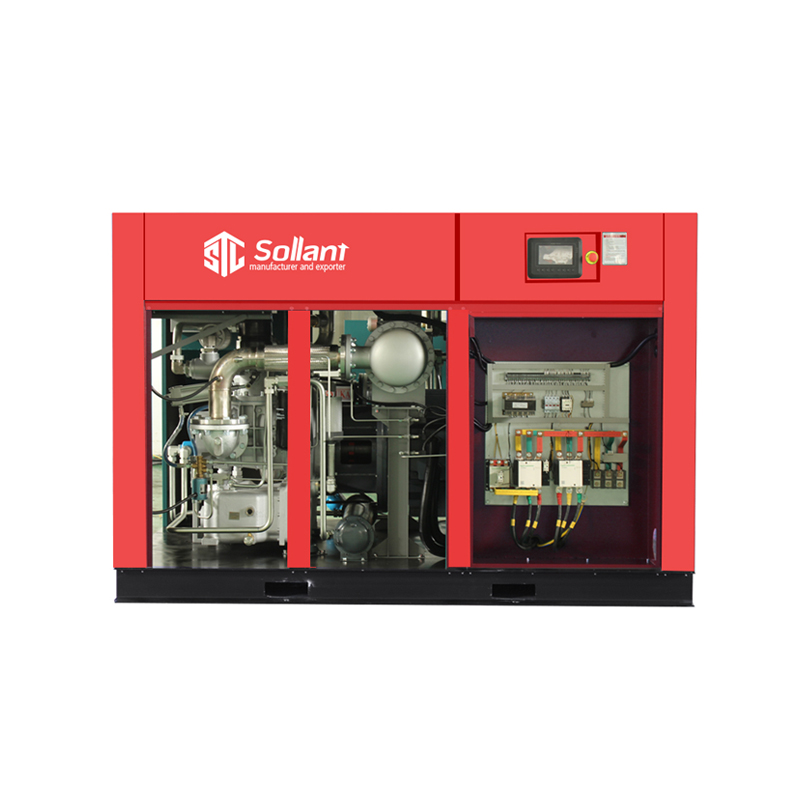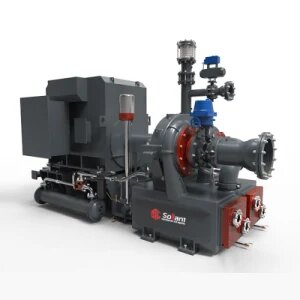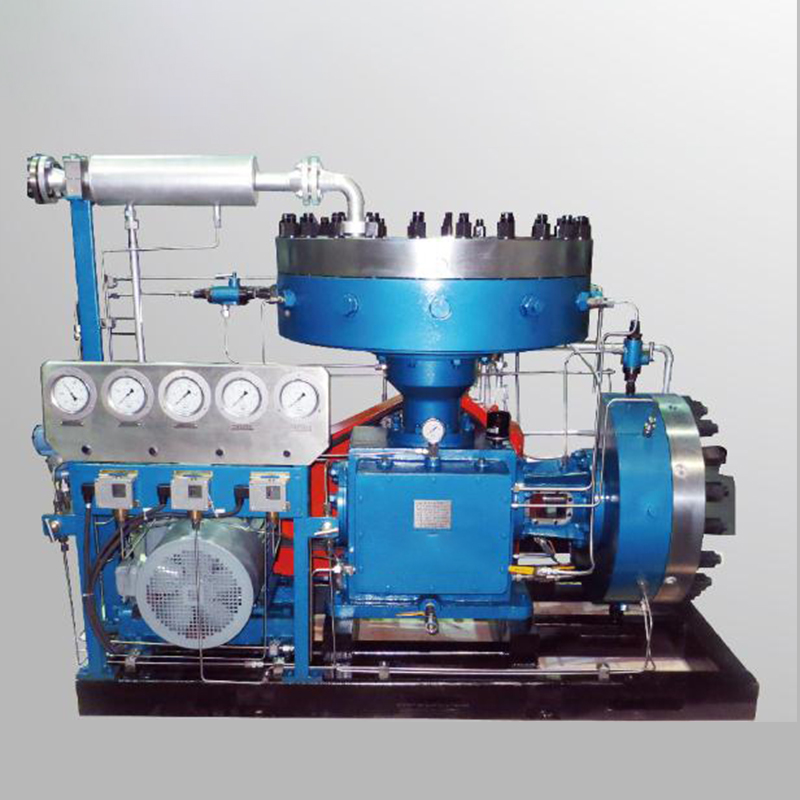A diaphragm compressor is a positive displacement machine used to increase the pressure of gases or gas mixtures.
It operates on a straightforward and reliable principle, making it valuable in various industrial applications where gas compression is necessary.

In this comprehensive guide, we’ll delve into the inner workings of a diaphragm compressor, exploring its components, operation, advantages, and applications.
1. Introduction to Diaphragm Compressors
A diaphragm compressor is a specialized machine used for compressing gases.
Unlike dynamic compressors, which rely on rotating impellers or vanes to increase gas pressure, diaphragm compressors employ a flexible diaphragm or membrane to achieve compression.
This diaphragm isolates the gas being compressed from the mechanical components of the compressor.
Diaphragm compressors are commonly used in industries where the compression of various gases, including corrosive, flammable, and toxic gases, is required.
Their design allows them to handle a wide range of gas compositions without the risk of contamination or leakage, making them ideal for applications demanding high levels of purity and safety.
2. Components of a Diaphragm Compressor
To understand how a diaphragm compressor works, it’s essential to familiarize yourself with its key components.
2.1 Diaphragm: The heart of a diaphragm compressor is the flexible diaphragm or membrane.
This diaphragm is typically constructed from materials such as metal, synthetic rubber, or other resilient materials.
It serves as a barrier that separates the gas to be compressed from the hydraulic fluid used to actuate the diaphragm.
2.2 Compression Chamber: The compression chamber is the main housing of the compressor, usually cylindrical in shape.
It contains the gas that is to be compressed.
The chamber has an inlet and an outlet for gas flow, each equipped with one-way valves to ensure gas moves in the desired direction.
2.3 Inlet and Outlet Valves: Diaphragm compressors are equipped with one-way inlet and outlet valves.
These valves allow gas to enter the compression chamber during the suction phase and exit during the discharge phase. The design of these valves ensures that gas flows in a unidirectional manner, preventing backflow.
2.4 Hydraulic System: The diaphragm is actuated by a hydraulic system, which typically utilizes hydraulic oil.
One side of the diaphragm is exposed to hydraulic pressure, while the other side is in contact with the gas to be compressed.

When hydraulic pressure is applied to one side of the diaphragm, it causes the diaphragm to move, altering the volume of the compression chamber and, consequently, the gas pressure.
3. The Compression Process
The operation of a diaphragm compressor can be broken down into three main phases: suction (intake), compression, and discharge.
3.1 Suction (Intake):
- At the beginning of the compression cycle, the diaphragm is in its downward or extended position.
- The gas to be compressed enters the compression chamber through the inlet valve as the diaphragm moves downwards.
- This movement creates a low-pressure area in the chamber, causing gas to flow in from the external source.
3.2 Compression:
- After the suction phase, the diaphragm begins to move upward.
- As the diaphragm rises, the volume of the compression chamber decreases.
- The reduction in volume causes the gas to be compressed, resulting in an increase in gas pressure.
- The flexible diaphragm accommodates the change in volume by flexing or curving without allowing any gas to leak into the hydraulic side.
3.3 Discharge:
- When the diaphragm reaches its maximum upward position, the gas inside the compression chamber has reached its maximum pressure.
- The outlet valve opens, allowing the high-pressure gas to exit the compression chamber.
- The gas is discharged from the compressor for further use or processing.
4. Types of Diaphragm Compressors
Diaphragm compressors come in various configurations to meet different operational requirements.
Two common types are single-acting diaphragm compressors and double-acting diaphragm compressors.
4.1 Single-Acting Diaphragm Compressors:
- Single-acting diaphragm compressors have one side of the diaphragm exposed to the gas to be compressed.
- Hydraulic pressure is applied to the other side of the diaphragm, causing it to move and compress the gas.
- These compressors are suitable for lower-pressure applications and are relatively simple in design.
4.2 Double-Acting Diaphragm Compressors:
- Double-acting diaphragm compressors have both sides of the diaphragm in contact with gas.
- Hydraulic pressure is applied alternately to both sides of the diaphragm, resulting in a more balanced and efficient compression process.
- These compressors are capable of handling higher pressures and are often used in more demanding applications.
5. Advantages of Diaphragm Compressors
Diaphragm compressors offer several advantages that make them preferred choices in certain applications:
5.1 Gas Purity:
- Diaphragm compressors are known for their ability to maintain gas purity. The gas being compressed is completely isolated from the hydraulic fluid and mechanical components, preventing contamination.
5.2 Versatility:
- They can handle a wide range of gases, including corrosive, toxic, and flammable gases, due to their seal-tight design.
5.3 High Pressure and Compression Ratios:
- Double-acting diaphragm compressors are capable of achieving high compression ratios and can handle high-pressure applications.
5.4 Safety:
- Their design minimizes the risk of gas leakage, making them safer for handling hazardous gases.
5.5 Reliability:
- Diaphragm compressors are known for their reliability and durability, requiring minimal maintenance compared to other types of compressors.
6. Applications of Diaphragm Compressors
Diaphragm compressors find applications across various industries due to their unique characteristics:
6.1 Chemical Processing:
- Used to compress and transfer specialty gases and chemicals in the production of pharmaceuticals, specialty chemicals, and semiconductors.
6.2 Petrochemical Industry:
- Employed in the handling and compression of gases used in petrochemical processes, such as hydrogen and ethylene.
6.3 High-Purity Gas Production:
- Ideal for producing high-purity gases used in industries like electronics and healthcare, where gas quality is critical.
6.4 Research and Laboratories:
- Used in research and laboratory settings to generate high-pressure gases for experiments and analysis.
6.5 Gas Storage:
- Applied in the compression and storage of gases for various purposes, including energy storage and transportation.
7. Maintenance and Safety
While diaphragm compressors are known for their reliability and safety, regular maintenance is still crucial to ensure their continued operation. Here are some maintenance and safety considerations:
- Diaphragm Inspection: Regularly inspect the diaphragm for signs of wear, damage, or fatigue. Replace the diaphragm as needed to maintain the compressor’s efficiency and safety.
- Hydraulic System Maintenance: Ensure the hydraulic system is properly maintained, including checking for leaks, maintaining fluid levels, and replacing hydraulic fluid at recommended intervals.
- Valve Maintenance: Inspect and maintain inlet and outlet valves to prevent gas leakage or improper operation.
- Safety Protocols: Implement safety protocols for handling gases, especially if they are hazardous or toxic. Ensure that relief valves and pressure safety devices are in place to prevent over-pressurization.
- Training: Provide training to personnel operating and maintaining diaphragm compressors to ensure safe and efficient operation.
8. Conclusion
In summary, a diaphragm compressor is a valuable piece of equipment used to increase the pressure of gases or gas mixtures.

Its unique design, featuring a flexible diaphragm that isolates the gas from the mechanical components, makes it suitable for a wide range of applications in various industries.
Diaphragm compressors offer advantages such as gas purity, versatility, and safety, and they are capable of handling high-pressure and high-purity gas requirements.
Proper maintenance and adherence to safety protocols are essential for ensuring the reliable and safe operation of diaphragm compressors in industrial settings.

 By Sollant
By Sollant

